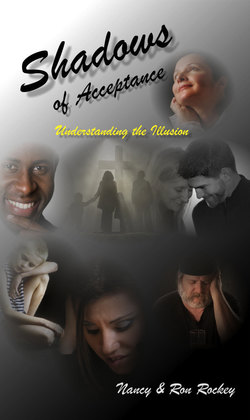Читать книгу Shadows Of Acceptance - Nancy Inc. Rockey - Страница 7
На сайте Литреса книга снята с продажи.
Fear:
ОглавлениеEveryone is born with a few basic fears such as falling and loud noises. All of our fears, whether they are real or just perceived, come from the conclusions we have formed about ourselves, the world around us, and the people in it.
Real fear is healthy, protective fear and is based on a valid conclusion about the world and its people. It can prevent us from choosing behaviors that will bring us harm, anxiety or other discomfort. It can, for example, prevent us from stepping into a poorly shaped and slippery bathtub without a rubberized mat to prevent a fall or walking out into a busy street without looking both ways first.
Mythical fear comes from faulty and self-defeating conclusions we form when we are trying to cope with toxic input from our culture or family. It is also a prediction of what will happen if we don’t make a particular choice. It is both limiting and destructive, and can prevent us from enjoying every day pleasures and relationships. Obsessions and compulsions often stem from this type of fear.
The brain is most impressionable in the first two years of life and learns seventy-five percent of all that is needed for life during that time. Our earliest messages are received through our emotions and experiences, and the most powerful and long-lasting of these become the foundation for our later thoughts, feelings and behaviors.
A difficult birth can make a lasting impression on the Reticular Activating System, which creates the set-point for the muscle tension or hyper-alertness in the body at the time of birth. If birth was complicated and the child’s life was in danger, fear kick-starts the Reticular Activating System, located at the base of the brain, and the infant’s muscles are set on tight or tense, and fear creates emotional tenseness, making the child anxious. The experiences of childhood or later life can increase or decrease the set point of the body’s tension. It should be noted that it is easier to increase the tension than it is to decrease it.
Origins of fear include:
1.Innate - Inborn (falling, loud noises etc.)
2.Frightening experiences in the womb (mother or child’s health)
3.Mother’s fears transferred through hormones to fetus
4.Reality – frightening experiences of life.
5.Faulty conclusions drawn about the world and its relation to us
6.Childhood modeling of primary caregiver’s fears.
7.Thoughts created and exaggerated from past memories
8.Perceptions – usually subtle associations from experiences
9.Body sensations which stimulate and cellular memories -- the language of the body telling us that arousal is occurring
10.Fictitious tales told to us by others, i.e. the “Boogy Man”
There are really only two basic emotions: love and fear. Fear drives all negative, self-protective and harmful emotions. Some people are totally controlled by their fears, and therefore miss out on a great deal of happy living. Fears make us control freaks, macho men, hysterical women and selfishness, jealousy, envy, anger, and a host of other unpleasant attitudes are ours to experience as a result of fear.
According to Alice Miller in her book, The Drama of Being a Child,
“. . . a child who was heavily traumatized at the beginning of his life will be in particular need of care and attention in order to overcome the fears arising out of more recent experiences” (34).
So, ask yourself when a fear arises: “Is this real or mythical?” “Where in childhood did this fear come from?” “If love is the opposite of fear, what would love do in this situation? Is it possible for me to break out of the shadow and into the light of courage and love?
